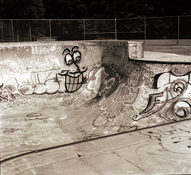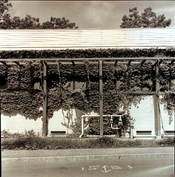What About Bob
Subscriber
I got the inspiration to try my hand at black and white reversal from @Ivo Stunga. Thanks!
Last night I developed black and white slides for the first time.
I mixed up PQ Universal concentrate and made two working developers: first developer at 1+5 with six grams of thiosulfate, pentahydrate, as the solvent and the second developer at 1+9. Some people were using 12 grams for the solvent and some were not using any at all. With that in mind and getting the idea that T-grained films needed some amount of solvent I decided to go in between at six grams.
I mixed up Sprint vanilla scented stop bath, sodium sulfite clearing bath with 50 grams of sulfite to a liter and Hypam fixer. I went with the potassium dichromate and sodium bisulfate bleach. 9.5 grams dichromate and 55 grams of bisulfate.
At first I did a bleach test with a tiny piece of old Tri-X film that failed big time. It was brought to my attention to just snip a piece off from the film that I was about to process. When I saw the results of the bleaching that was the green light to go.
The default first development time on Ilford's site is 12:00. I used 10:45 to compensate for the temperature of 69.8F/21C. Rest of the chemistry was around 70 to 70.5F/21.1 to 21.3C.
Bleaching was determined to be 3:00 followed by a couple of rinse cycles and then the clearing bath for 1:00. I used that twirly thingy on top of the AP Tank for agitation. Agitation was constant for the bleaching and clearing.
I wore gloves, mask and eye protection when mixing the dichromate and I worked slowly. Probably didn't need the mask after the powder was in solution but I kept it on anyway. I used trays to hold the container and graduate for the dichromate solution. Nearby I had a sprayer loaded with metabisulfite in case there were any drips in the tray. Nothing contacted the work surface. No spills at all. Anything that came into contact with the bleach was put into an Igloo type container: spoons, weighing cup, stirrer and a few other things in separate ziplok baggies in the Igloo container, separated from the other stuff.
I wanted to lessen the variables as much as possible for the time being and not use the permanganate version bleach until later because of some of the horror stories I have read regarding that type of bleach, even when diluted there were some users having problems with it. I will give the permanagante style bleach a chance.
What was very exciting for me was the re-exposure step. I used a GE 60 watt, soft white, LED bulb at about a foot above the rim of the bowl. I kept the film on the reel and had it in a bright white bowl that measures 11 inches in diameter and about 5.75 inches depth, no water, and gave each side of the reel 1:00 of exposure while rotating the reel off-and-on. When the light was turned on I noticed images slowly appearing on the film! It was magical to witness mini images coming up on a milky light roll right before my very eyes! I did back the distance down by another foot or so when I noticed more of the images coming up. Kind of reminded me of overcooking, lol.
Second developer was for six minutes at 70.5F/21.3C, stop, rinse, fix, wash, photo-flo and hang to dry.
I really enjoyed this process and the experience. The brown tone is nice but I would like to try for a more neutral tone. I was informed that the brown tone is from the very fine grain nature of the film. I omitted the benzotriazole from the PQ recipe because I read that it shifts the tone on papers from warm to neutral, didn't mention anything about films and since I already had bromide and a solvent being used I thought it may end up being overkill. My main concern was that there could be a loss of shadow detail using that chemical along with the other restrainer. On my next batch mix of PQ I will add the benzotriazole and see if that makes any difference with the tone.
I am also thinking to maybe slightly increase the solvent from six grams to 6.5/7 and bring the first development time from 10:45 to 11:00 to even things out.
I used a Canon T5 to capture the frames and I had to do some fiddling with the brown tone because it was being recorded a little deeper than normal along with a pinkish overlay which doesn't show on the film when viewed in daylight. When the film is viewed in daylight the images are a very slight and nice looking tinted brown. The brown sort of reminds me of a pyrocat negative but in this case a pyrocat positive. The DSLR capture doesn't do the film justice. Looking through a magnifier on the light pad the clarity and sharpness of the images are amazing!
Please forgive the tininess of my little light pad table. I could almost fit three images per strip on it. Included are two test shots.
Last night I developed black and white slides for the first time.
I mixed up PQ Universal concentrate and made two working developers: first developer at 1+5 with six grams of thiosulfate, pentahydrate, as the solvent and the second developer at 1+9. Some people were using 12 grams for the solvent and some were not using any at all. With that in mind and getting the idea that T-grained films needed some amount of solvent I decided to go in between at six grams.
I mixed up Sprint vanilla scented stop bath, sodium sulfite clearing bath with 50 grams of sulfite to a liter and Hypam fixer. I went with the potassium dichromate and sodium bisulfate bleach. 9.5 grams dichromate and 55 grams of bisulfate.
At first I did a bleach test with a tiny piece of old Tri-X film that failed big time. It was brought to my attention to just snip a piece off from the film that I was about to process. When I saw the results of the bleaching that was the green light to go.
The default first development time on Ilford's site is 12:00. I used 10:45 to compensate for the temperature of 69.8F/21C. Rest of the chemistry was around 70 to 70.5F/21.1 to 21.3C.
Bleaching was determined to be 3:00 followed by a couple of rinse cycles and then the clearing bath for 1:00. I used that twirly thingy on top of the AP Tank for agitation. Agitation was constant for the bleaching and clearing.
I wore gloves, mask and eye protection when mixing the dichromate and I worked slowly. Probably didn't need the mask after the powder was in solution but I kept it on anyway. I used trays to hold the container and graduate for the dichromate solution. Nearby I had a sprayer loaded with metabisulfite in case there were any drips in the tray. Nothing contacted the work surface. No spills at all. Anything that came into contact with the bleach was put into an Igloo type container: spoons, weighing cup, stirrer and a few other things in separate ziplok baggies in the Igloo container, separated from the other stuff.
I wanted to lessen the variables as much as possible for the time being and not use the permanganate version bleach until later because of some of the horror stories I have read regarding that type of bleach, even when diluted there were some users having problems with it. I will give the permanagante style bleach a chance.
What was very exciting for me was the re-exposure step. I used a GE 60 watt, soft white, LED bulb at about a foot above the rim of the bowl. I kept the film on the reel and had it in a bright white bowl that measures 11 inches in diameter and about 5.75 inches depth, no water, and gave each side of the reel 1:00 of exposure while rotating the reel off-and-on. When the light was turned on I noticed images slowly appearing on the film! It was magical to witness mini images coming up on a milky light roll right before my very eyes! I did back the distance down by another foot or so when I noticed more of the images coming up. Kind of reminded me of overcooking, lol.
Second developer was for six minutes at 70.5F/21.3C, stop, rinse, fix, wash, photo-flo and hang to dry.
I really enjoyed this process and the experience. The brown tone is nice but I would like to try for a more neutral tone. I was informed that the brown tone is from the very fine grain nature of the film. I omitted the benzotriazole from the PQ recipe because I read that it shifts the tone on papers from warm to neutral, didn't mention anything about films and since I already had bromide and a solvent being used I thought it may end up being overkill. My main concern was that there could be a loss of shadow detail using that chemical along with the other restrainer. On my next batch mix of PQ I will add the benzotriazole and see if that makes any difference with the tone.
I am also thinking to maybe slightly increase the solvent from six grams to 6.5/7 and bring the first development time from 10:45 to 11:00 to even things out.
I used a Canon T5 to capture the frames and I had to do some fiddling with the brown tone because it was being recorded a little deeper than normal along with a pinkish overlay which doesn't show on the film when viewed in daylight. When the film is viewed in daylight the images are a very slight and nice looking tinted brown. The brown sort of reminds me of a pyrocat negative but in this case a pyrocat positive. The DSLR capture doesn't do the film justice. Looking through a magnifier on the light pad the clarity and sharpness of the images are amazing!
Please forgive the tininess of my little light pad table. I could almost fit three images per strip on it. Included are two test shots.


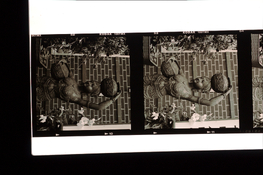
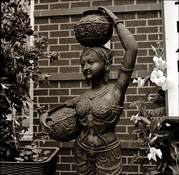
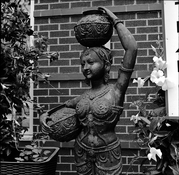
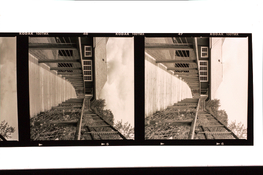
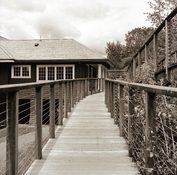
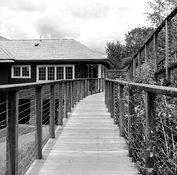

 I can''t believe I posted all that and didn't include the data. This is a first for me.
I can''t believe I posted all that and didn't include the data. This is a first for me. 
